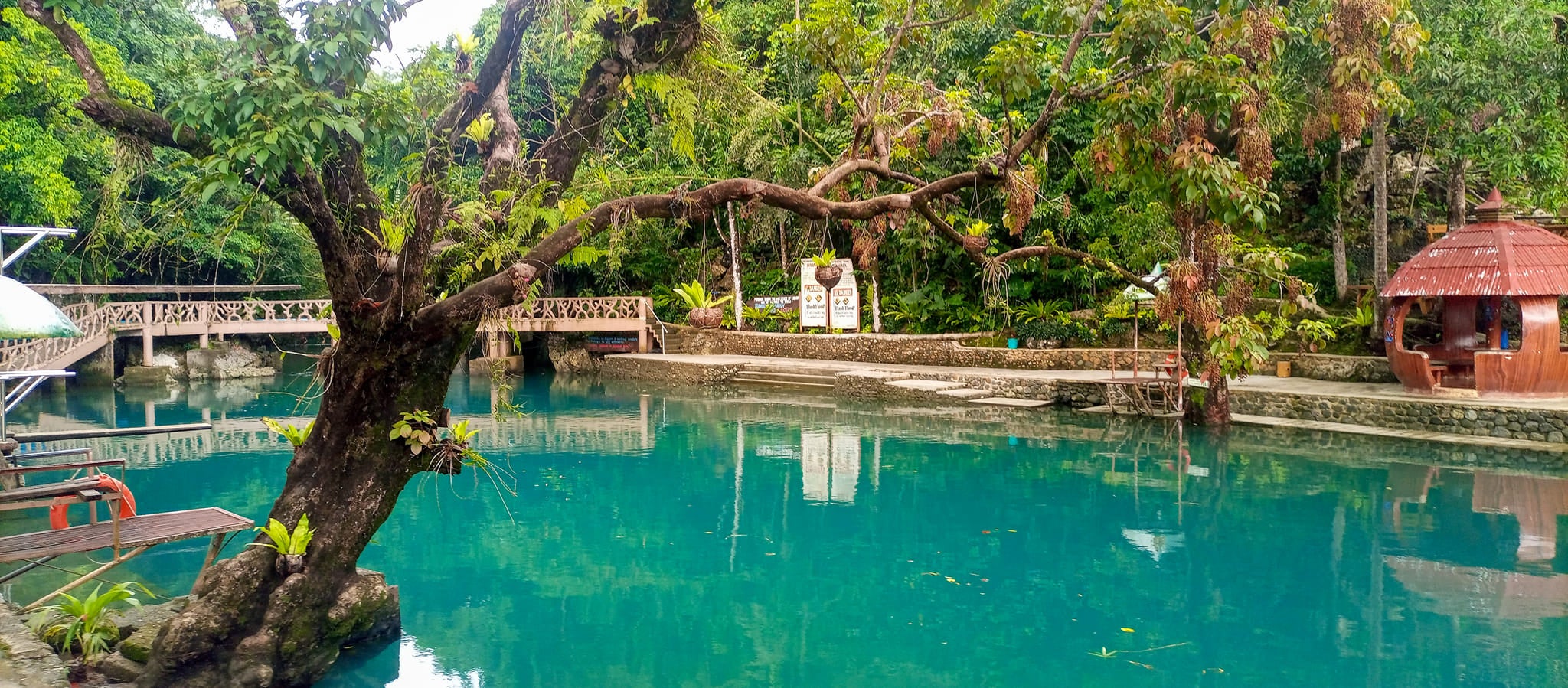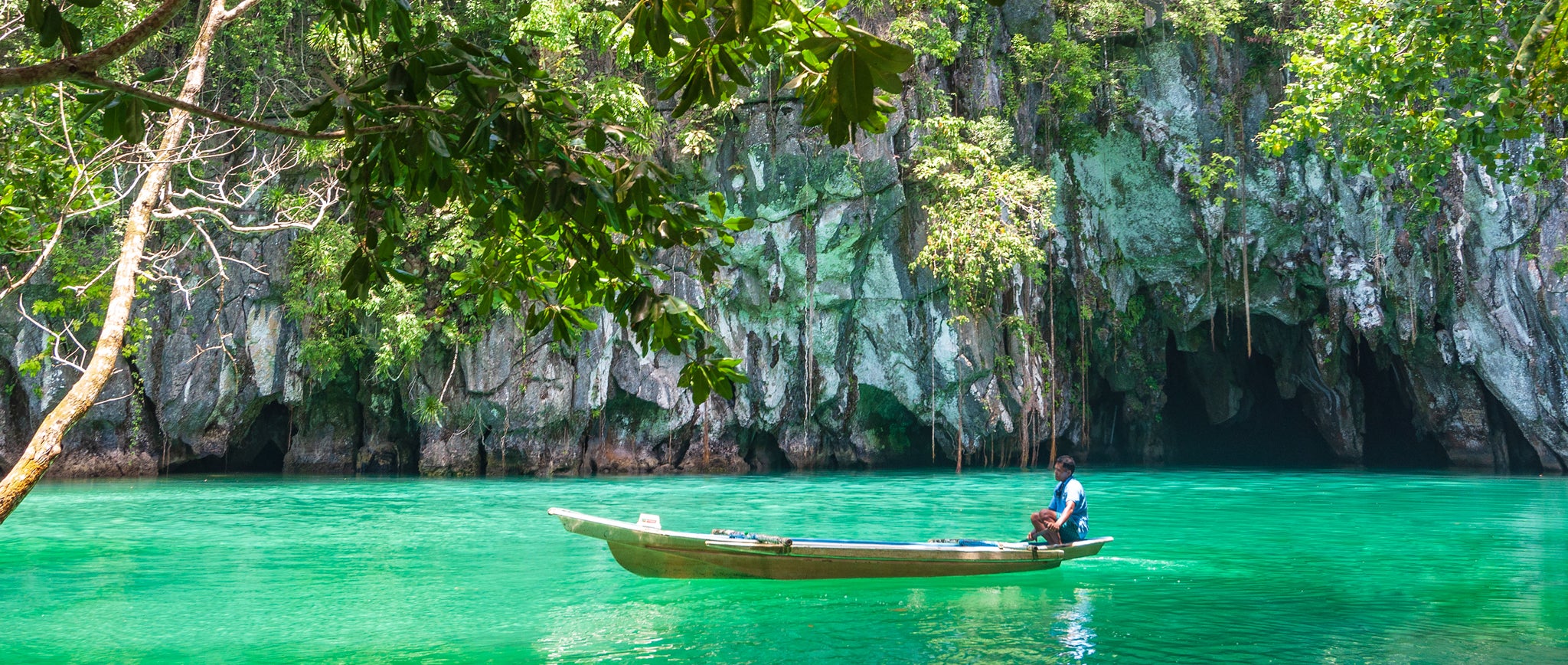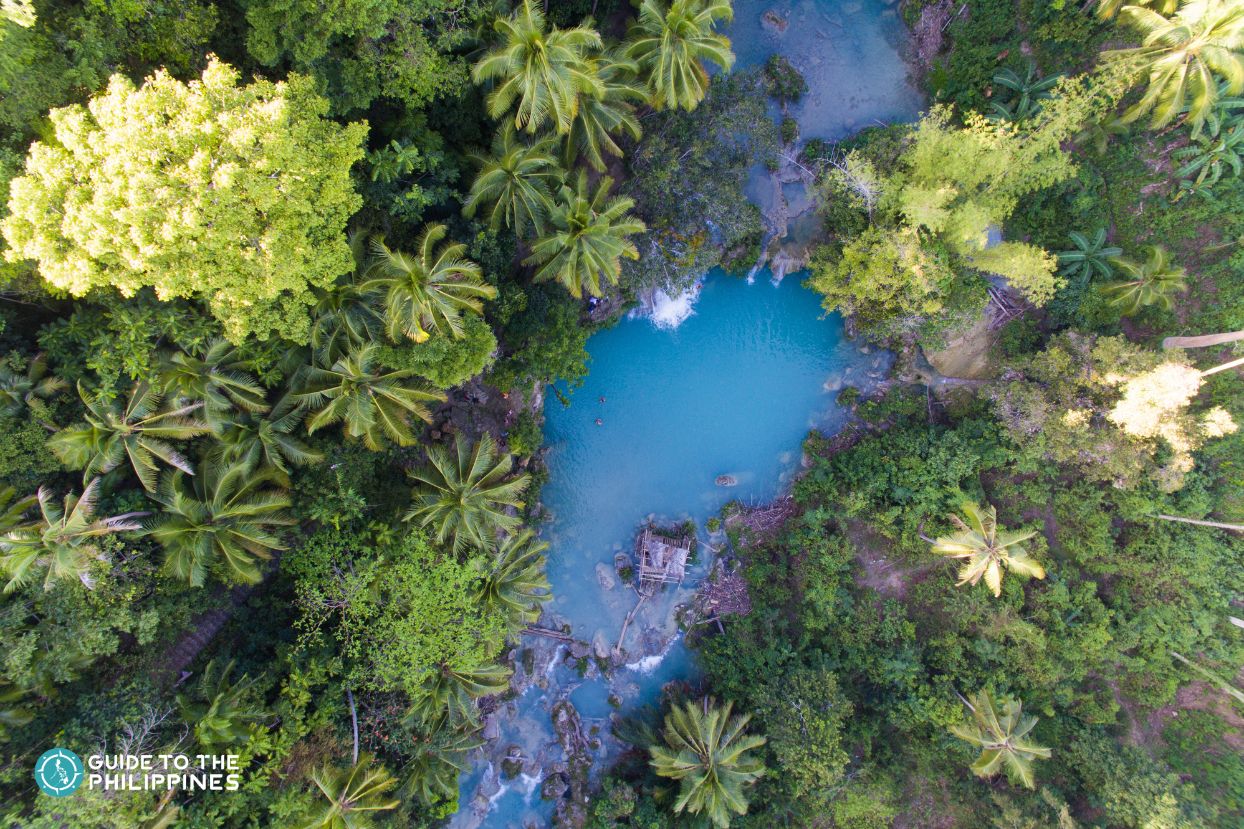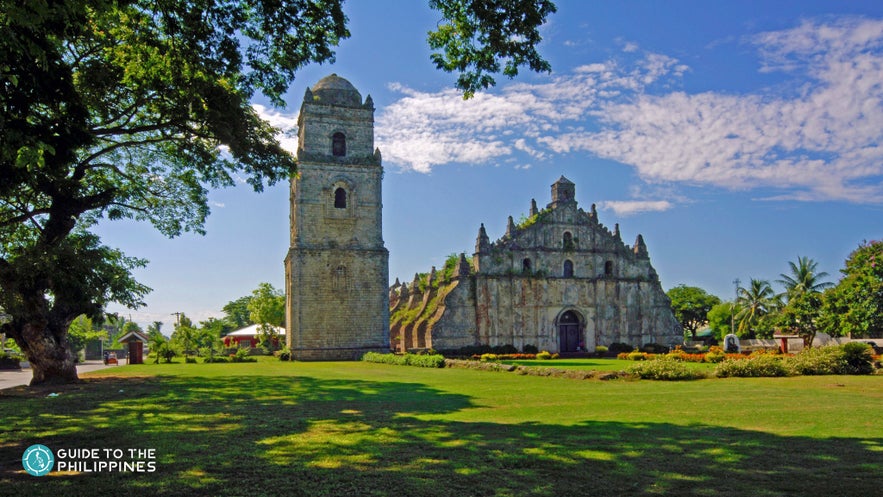
Located along the northwestern coast of Luzon Island, the provinces of Ilocos Norte and Ilocos Sur in the Ilocos Region are home to some of the Philippines’ most captivating historical landmarks and natural wonders. If you’re after scenic views, rich culture, and a touch of adventure, tours around Ilocos Region offer the perfect mix of heritage, nature, and unforgettable local experiences.
Ilocos Sur is best known for Vigan City, a UNESCO World Heritage Site that feels like stepping into a living museum, with its cobblestone streets, well-preserved Spanish colonial houses, and charming calesa rides. Up north in Ilocos Norte, you'll discover the stunning Kapurpurawan Rock Formation, the powdery white-sand beaches of Pagudpud town, the iconic Bangui Windmills, and heart-racing 4x4 dune rides near Laoag City.
Whether you're dreaming of a laid-back tropical escape, eager to dive into rich history and culture, or looking for thrilling adventures, Ilocos region has something for you. Read on to discover the best places to visit and top things to do in the provinces of Ilocos Norte and Ilocos Sur.
Key Takeaways
-
Ilocos Norte and Ilocos Sur are known for their rich cultural heritage, stunning natural attractions, historical sites, and unique cuisine. The region offers a well-rounded mix of experiences—perfect for travelers seeking a relaxing beach day, cultural immersion, scenic landscapes, or outdoor adventure.
-
Vigan City and Laoag City are top destinations for cruise passengers docking at Currimao Port. These heritage cities are ideal for a quick yet meaningful day tour during your cruise stop in Ilocos region. You can book private shore excursions with convenient cruise port pickup and drop-off for a smooth, hassle-free experience.
-
Vigan City is a must-visit site, famous for its well-preserved Spanish colonial architecture that earned it a spot on the UNESCO World Heritage Sites list.
-
Saud Beach and Blue Lagoon in Pagudpud town are among the best white sand beaches in the Philippines.
-
A 4x4 ride across the sand dunes near Laoag City is one of the top thrilling activities to try in the Philippines.
-
Kapurpurawan Rock Formation is a stunning natural attraction you won’t want to miss.
-
Immerse in local culture with a horse-drawn carriage ride along Calle Crisologo or try your hand at pottery-making at the Pagburnayan Jar Factory.
-
Must-try Ilocano dishes include the iconic Ilocos empanada, a deep-fried rice-flour pastry filled with longganisa (Ilocano sausage), egg, and vegetables.
-
Notable churches to add to your itinerary include Vigan Cathedral, Paoay Church, and Bantay Church.
-
Don’t miss Patapat Viaduct and the Bangui Windmills—two remarkable feats of engineering in Ilocos Norte Province.
-
The best time to visit the Ilocos Region is during the dry season, from December to May.
-
You’ll need at least 2 days to explore the highlights of the Ilocos Region and enjoy its top attractions.
-
You can also easily find and book tour packages to Ilocos Region with roundtrip transportation from Manila City for a convenient and hassle-free experience.
To help you plan your getaway, here are the top tourist spots in Ilocos Region that you shouldn't miss.
12. Pagburnayan Jar Factory
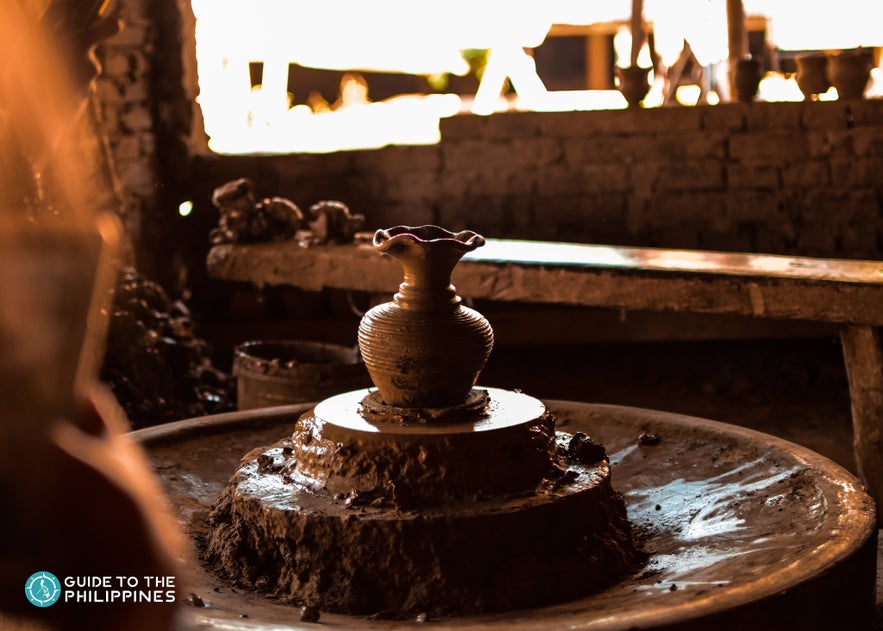
One of the most immersive things to do in the Ilocos Region is visiting the Pagburnayan Jar Factory in Vigan City, located in the province of Ilocos Sur. Known for its rich cultural heritage, Vigan City is home to this centuries-old pottery site where the traditional art of making burnay—unglazed earthen jars—continues to thrive. This craft was introduced by Chinese traders who settled in the area during colonial times.
At the factory, you can try shaping clay using a manual pottery wheel and traditional tools. It’s a hands-on cultural experience that lets you get creative with your design. You can then bake the jars in in-ground kilns to set them in shape.
This unique activity is one of the top cultural experiences you can try when you book tours to Vigan City. Aside from learning the technique, you’ll also hear stories about the origins of the craft and how it’s being preserved for future generations.
More than just a memorable souvenir, these jars are still used by locals today to ferment native vinegar and artisanal wines—adding practical value to their cultural significance.
11. Blue Lagoon Beach
Blue Lagoon Beach in Pagudpud town is one of the most stunning coastal escapes in Ilocos Norte Province. With its powdery white sand, clear turquoise waters, and peaceful vibe, it’s the perfect place to slow down and soak in nature’s beauty. Nestled between rolling green hills and swaying coconut trees, this postcard-worthy beach stands out as one of the top places to visit in Pagudpud town.
You can swim in its gentle waves, lounge under the sun, or take long, barefoot walks along the wide shoreline. It’s a family-friendly spot, and if you’re feeling adventurous, you’ll find locals offering fun water activities like paddleboarding, snorkeling, and even surfing when the waves are just right.
There are plenty of places to stay nearby—from simple homestays to beachfront resorts—so you can extend your visit and catch the magical sunset. Don’t miss the chance to fall asleep to the sound of the waves and wake up to a peaceful tropical morning. A visit to Blue Lagoon Beach adds a refreshing and unforgettable touch to your adventure in Ilocos Norte Province.
10. Cape Bojeador Lighthouse
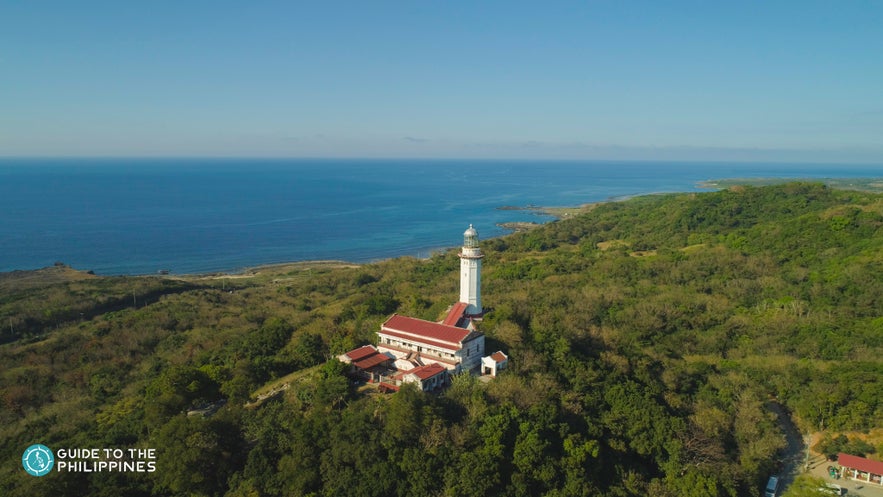
Cape Bojeador Lighthouse in the town of Burgos, Ilocos Norte, is a historic structure, also known as the Burgos Lighthouse. It dates back to the Spanish colonial era and is recognized as one of the highest-elevated lighthouses in the Philippines.
Standing 66 feet tall on Vigia de Nagpartian Hill, the octagonal stone tower overlooks Cape Bojeador and the West Philippine Sea. First lit in 1892, it has long served as a vital guide for seafarers navigating the country’s northwestern coastline.
Despite its age, the lighthouse remains operational and is regularly maintained. While much of its original design has been preserved, a few modern updates have been added to ensure smooth functionality. For instance, the original Fresnel lens lamp—once lit by pressurized kerosene—was replaced in the 1990s with a solar-powered system after an earthquake damaged the region.
The lighthouse was initially designed by Spanish engineer Magin Pers y Pers in 1887 and later completed under Guillermo Brockman as part of a broader Spanish initiative to illuminate the Philippine archipelago.
Today, Cape Bojeador Lighthouse stands not only as a functioning beacon but also as a National Cultural Treasure and a National Historical Landmark, making it a must-visit for history enthusiasts exploring Ilocos Norte Province.
9. Vigan Cathedral
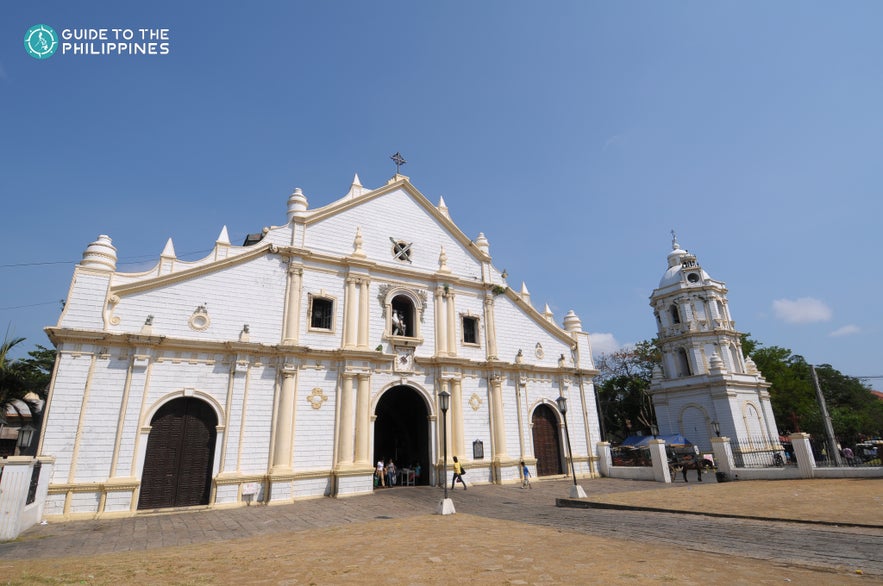
Vigan Cathedral, also known as the Saint Paul Metropolitan Cathedral, is one of the most iconic churches in Ilocos Region and one of the top places to visit in Vigan City. Located in front of Plaza Salcedo, this holy building stands as a prominent feature of the city’s historical landscape, often photographed alongside the plaza.
The construction of the cathedral dates back to 1574 when Spanish conquistador Juan de Salcedo ordered the building of a temporary church in Vigan. At first, the structure was made from wood and stalk, a simple design that would later be replaced by a sturdier building in 1641—the first official Vigan Cathedral.
The church has faced its share of challenges, being damaged by two major earthquakes and eventually burned down in 1739. After these setbacks, the current version of the cathedral was completed in the 1800s under the direction of Augustinian priests.
The cathedral showcases a stunning Baroque style, highlighted by large buttresses on either side. Inside, visitors will find a silver-paneled altar, 12 minor altars, and brass altar railings. To the south of the church stands a 25-meter-high bell tower that symbolizes St. Peter, completing the awe-inspiring sight.
8. Patapat Viaduct
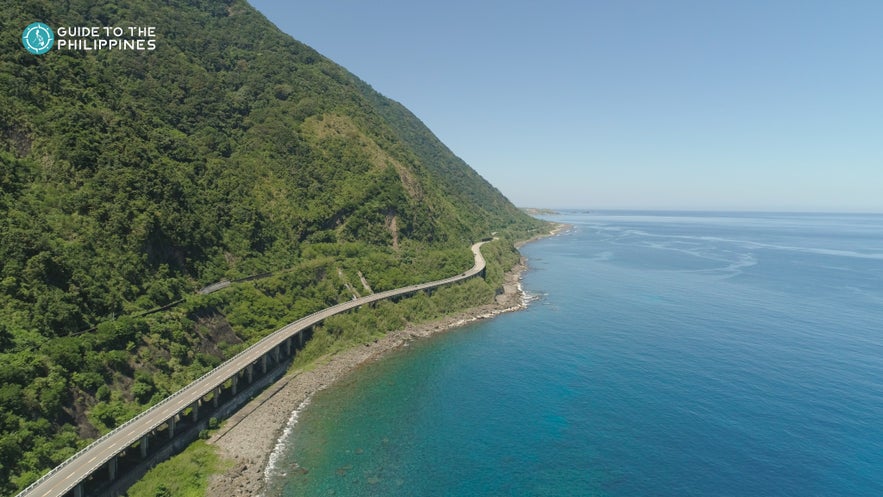
The Patapat Viaduct is one of the most scenic drives you’ll find in Ilocos Norte Province. Stretching about 12 kilometers, it’s among the longest bridges in the Philippines. Located at the foot of the Northern Cordillera Mountain Range in Pagudpud town, this elevated coastal highway treats you to sweeping views of Pasaleng Bay and the lush, forested cliffs beside it.
Standing about 31 meters above sea level, the viaduct is not only an important connection between Pagudpud and the neighboring province of Cagayan Valley, but it also provides breathtaking scenic vistas. Opened to the public in October 1986, it replaced a footbridge that once linked the two provinces, and has since become a must-see stop for travelers.
Nicknamed the "French Riviera of the Northern Philippines," the Patapat Viaduct is a popular highlight in tours around Pagudpud town, attracting visitors who stop to take in the panoramic views. The crystal-clear waters of Pasaleng Bay and the picturesque surroundings make it a perfect spot for photo opportunities.
Visitors can also glimpse half of a shipwreck from the Japanese occupation era, with the other half believed to lie submerged in the waters of Agua Grande, further along the bridge.
7. Bantay Church Bell Tower

Make sure to add Bantay Church Bell Tower to your list of spots to visit in Ilocos Sur Province. Dating back to 1591, this historic bell tower is one of the oldest in the region and holds a fascinating past. Originally used as a watchtower during the Spanish era and World War II, it now serves as a belfry for the nearby Bantay Church, a beautiful example of the area's rich heritage.
While you can admire the tower from below, don't miss the chance to climb the steps that lead to the top. The winding stairs take you to the historic bell, and the panoramic view from the top is absolutely worth the effort. From here, you'll get a bird’s-eye view of the Bantay district and the surrounding areas, making it a perfect spot for photos.
Take some time to wander around the peaceful grounds of Bantay Church as well. The lovely gardens and religious statues create a tranquil atmosphere, giving you a deeper sense of the local culture. This is truly a must-see attraction for anyone visiting Vigan!
6. Sand Dunes

Photo by Department of Tourism
Ilocos Norte Province is home to some of the most exciting natural wonders, and the Paoay and La Paz Sand Dunes are definitely not to be missed. As one of the top spots to visit around Laoag City, these vast sandy landscapes offer a thrilling alternative to the usual beach activities, providing you with a unique adventure in the heart of Ilocos Region.
Booking a 4x4 ride to experience the thrill and beauty of this landscape is a highlight in many tours to Laoag City.
The La Paz Sand Dunes, located near the West Philippine Sea, stretch across 85 square kilometers and feature towering sand dunes that can reach up to 30 meters high! Locals call this area Bantay Bimmaboy, and its vastness extends into the neighboring municipalities of Currimao and Pasuquin. On the other hand, the Paoay Sand Dunes, located near Suba Beach, span 88 square kilometers and offer equally exhilarating adventures.
Don’t miss the chance to try sandboarding here, riding a board down the slopes of the dunes for an unforgettable experience. You can explore this unique natural wonder when you book a guided tour to Laoag City's top attractions.
For a truly hassle-free trip, consider booking a 3-day Ilocos Norte Province tour package with airfare to Laoag City. This vacation package already includes flights to ensure your travel is smooth and seamless. You can simply relax and enjoy everything from the sand dunes to the rich history and culture of the area. With everything arranged for you, your only focus will be on having fun!
5. Saud Beach

Photo by Department of Tourism
Saud Beach in Pagudpud town is a tropical gem you shouldn’t miss. Recognized by international travel magazines for its powdery white sand and calm, crystal-clear waters, this pristine beach has earned a reputation as one of the best beaches near Manila City. Stretching about 2 kilometers, it offers the perfect setting for a peaceful seaside escape.
You can take a refreshing swim, try snorkeling, or just float and unwind in the cool waters. Don’t forget to snap a few photos while wading in the shallows—the view of Pagudpud town in the background is simply picture-perfect. Between dips in the sea, relax in one of the cozy cabanas nestled beneath the swaying palm trees that line the beach.
If you want the best weather for your beach day, plan your visit between January and early May. The skies are usually clear during these months, making it the ideal time to enjoy the sun, sea, and scenery at Saud Beach.
4. Kapurpurawan Rock Formation
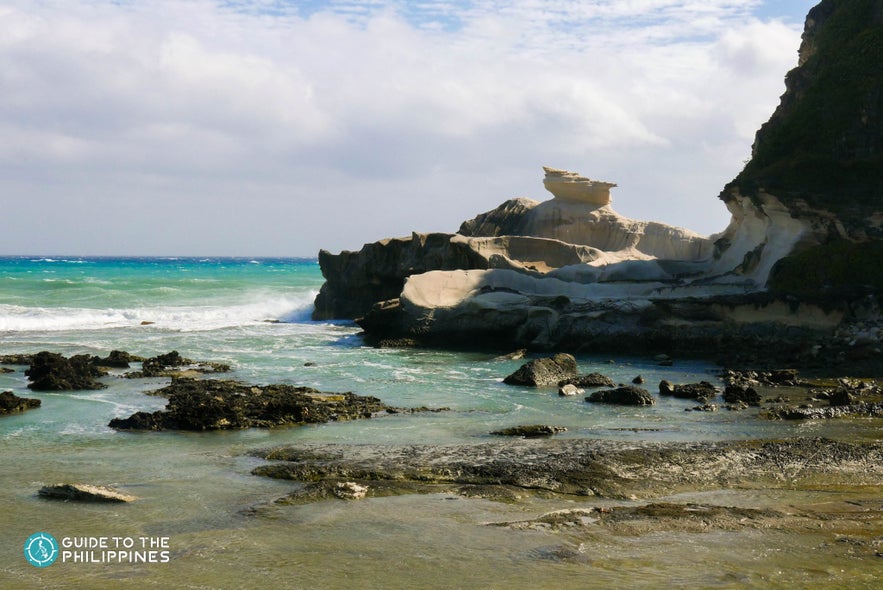
The Kapurpurawan Rock Formations in Ilocos Norte Province are a must-see when you're exploring the north. These iconic white sandstone formations, located along the rugged coast of Bangui Bay, get their name from the Ilocano word “puraw,” which means white—a perfect description of their natural, chalky color.
Carved by years of wind and waves, the formations feature striking curves and smooth surfaces that look almost otherworldly. It’s no wonder this scenic spot is a favorite highlight of any tour in Ilocos Norte Province.
To get there, enjoy a short scenic hike through lush landscapes dotted with greenery and natural pools. You can also ride a horse for a more relaxed journey. Either way, the trail adds a touch of adventure and lets you take in the area’s natural beauty.
Once you reach the site, you’ll be greeted by sweeping views of Bangui Bay and towering rock structures. Don’t miss the famous anvil-shaped rock—one of the most photographed spots in the area. You can even climb certain sections to get a closer look at the formations shaped gracefully by the sea breeze.
3. Paoay Church
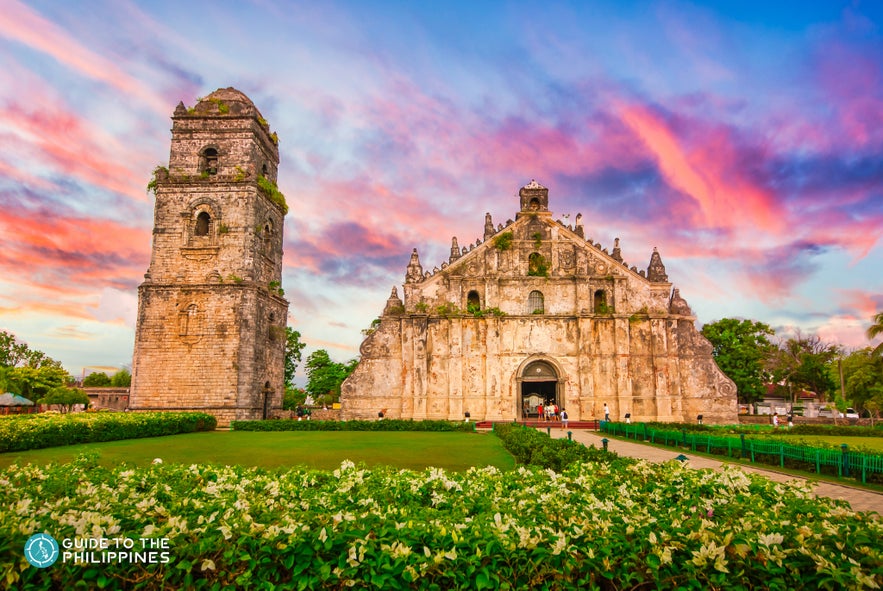
When you're in Laoag city in Ilocos Norte Province, be sure to visit the stunning Paoay Church, also known as the Saint Augustine Church. Completed in 1710, this Roman Catholic church took nearly two decades to build, and it remains one of the most iconic landmarks in the Philippines.
Paoay Church is recognized as one of the UNESCO World Heritage Sites in the Philippines, renowned as one of the most beautiful Baroque churches in the country. It was also named a National Cultural Treasure in 1973, underscoring its historical significance.
Built in the baroque style, the church’s design features a wide base, massive buttresses, and coral stone walls, all contributing to its grandeur. Its facade even draws inspiration from Javanese architecture, closely resembling elements of the Borobudur temple in Java, Indonesia.
Don’t forget to check out the church's bell tower, a striking three-story structure separate from the main building. Once used as an observation post during key historical conflicts, it adds to the church’s rich history. If you're lucky, you may even be able to attend mass here, celebrated in English, Filipino, or Ilocano. A visit to Paoay Church is a journey back in time and a must-see when in Ilocos Norte Province.
2. Bangui Windmills
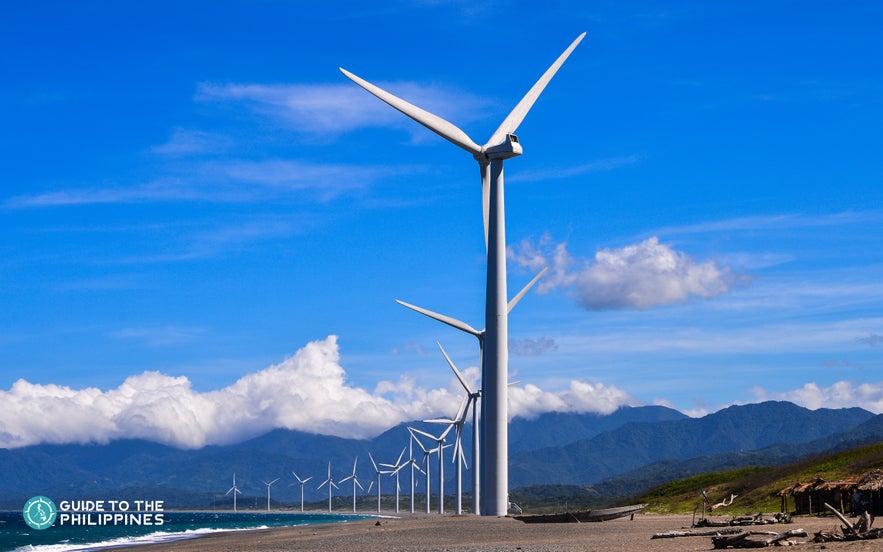
Be sure to include the Bangui Windmills in your list of where to go in the Ilocos Norte Province. Set against the stunning backdrop of Bangui Bay and the West Philippine Sea, these 26 towering white turbines create a striking coastal silhouette. Each one stands at 70 meters tall with blades stretching up to 41 meters—watching them spin in unison is both calming and captivating.
Built in phases starting in 2005, the Bangui Windmills make up the Philippines’ very first wind farm. They supply over 40% of Ilocos Norte’s electricity via the Luzon Grid. Thanks to their open coastal location, they efficiently harness strong sea breezes while showcasing a successful model of sustainable energy.
Beyond their role in clean power, these windmills have become one of the most iconic photo spots in the province. The most photographed turbines stretch along a scenic 9-kilometer shoreline. Don’t miss the chance to visit this landmark as part of a tour to Bangui Windmills and top spots in Ilocos Norte Province—it’s the kind of experience that blends nature, innovation, and unforgettable views.
1. Calle Crisologo
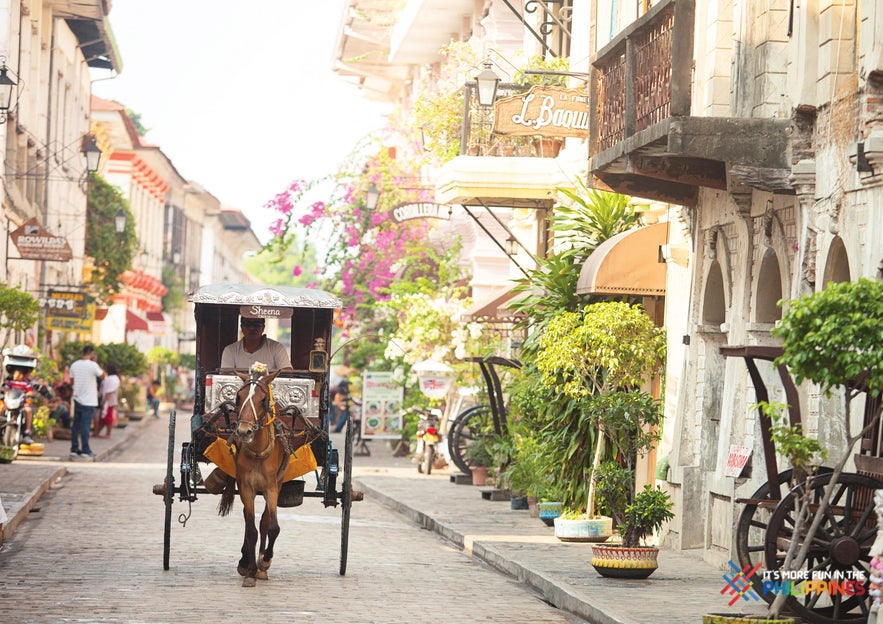
Photo by Department of Tourism
A trip to Vigan City, a charming city in Ilocos Sur Province, wouldn’t be complete without a leisurely walk along Calle Crisologo, one of the most iconic streets in the Philippines. This 500-meter cobblestone road is lined with beautifully preserved Spanish-era homes that transport you back in time.
Part of Vigan City’s Heritage Village, a UNESCO Heritage Site, Calle Crisologo is home to around 200 restored homes dating back to the 16th century. You can fully soak in the old-world charm—whether you're walking or enjoying a relaxing ride on a traditional kalesa (horse-drawn carriage). As you stroll down the street, you’ll find ancestral houses turned into cozy cafés, local restaurants, and shops.
While in the city, be sure to try Ilocos specialties like empanada, freshly cooked and bursting with flavor. You’ll also spot colorful handicrafts, woven items, and woodwork made by local artisans—perfect souvenirs to bring home a piece of the region’s artistry.

For a more immersive experience, consider booking a 3-days 2-nights Ilocos Tour Package at Vigan City's Hotel Luna, a stunning 4-star Colonial-style accommodation in the heart of this heritage city. A stay at Hotel Luna is unique, as it’s the only museum hotel in the Philippines. It’s perfect for those seeking a blend of luxury, culture, and relaxation in one of the most picturesque cities in the Philippines.
Must-Try Shore Excursions at Ilocos Port for Cruise Passengers
If you’re arriving in the Ilocos Region by cruise ship, you’re in for a treat. Currimao Port serves as the main gateway to unforgettable day trips across Ilocos Sur and Ilocos Norte provinces, both home to some of the Philippines’ most iconic heritage destinations.
Whether you're docked for just a few hours or a full day, there are guided shore excursions that make it easy to explore the region’s top attractions—complete with cruise port pickup and drop-off for a smooth, worry-free experience.
Immersive Heritage Tour to Vigan City's Top Attractions
A favorite among cruise passengers is the private Vigan City shore excursion from Currimao Port. This guided day tour includes hassle-free pickup and drop-off at the cruise terminal and brings you to Vigan’ Citys most iconic heritage sites.
Walk along the cobblestone streets of Calle Crisologo, admire the Neo-Gothic Bantay Church Bell Tower, try your hand at traditional pottery-making at the Pagburnayan Jar Factory, and explore the National Museum of the Philippines – Ilocos Regional Complex.
This tour is perfect for cruise passengers looking for a quick yet meaningful cultural experience during their stop in Ilocos Region. With a expert local guidance, and a worry-free return to your cruise ship, it’s one of the best ways to experience Vigan City in just a few hours.
Cultural Day Trip to Laoag City's Landmarks
Another excellent option is a private shore excursion to Laoag City, specially designed for cruises docking at Currimao Port with convenient pickup and drop-off at the terminal. As the capital of Ilocos Norte Province, Laoag is a vibrant city rich in history, featuring colonial architecture and cultural landmarks that showcase the region’s deep-rooted Ilocano heritage.
This guided tour takes you to top attractions such as the Sinking Bell Tower, St. William’s Cathedral, and the iconic Paoay Church—a UNESCO World Heritage Site known for its unique Baroque design. With a dedicated local driver-guide and worry-free transport from your cruise ship, this shore excursion offers an immersive cultural experience in just a few hours.
Make the most of your cruise stop in Ilocos Region
These curated tours are among the best things to do during a cruise stop in Ilocos Region. Whether you choose the charming streets of Vigan City or the historic sights of Laoag City, you’ll return to your cruise ship with lasting memories of stunning architecture, vibrant culture, and warm Ilocano hospitality—all in just one day.
Discover the Charm of the North: A Journey Through History, Culture, and Coastlines
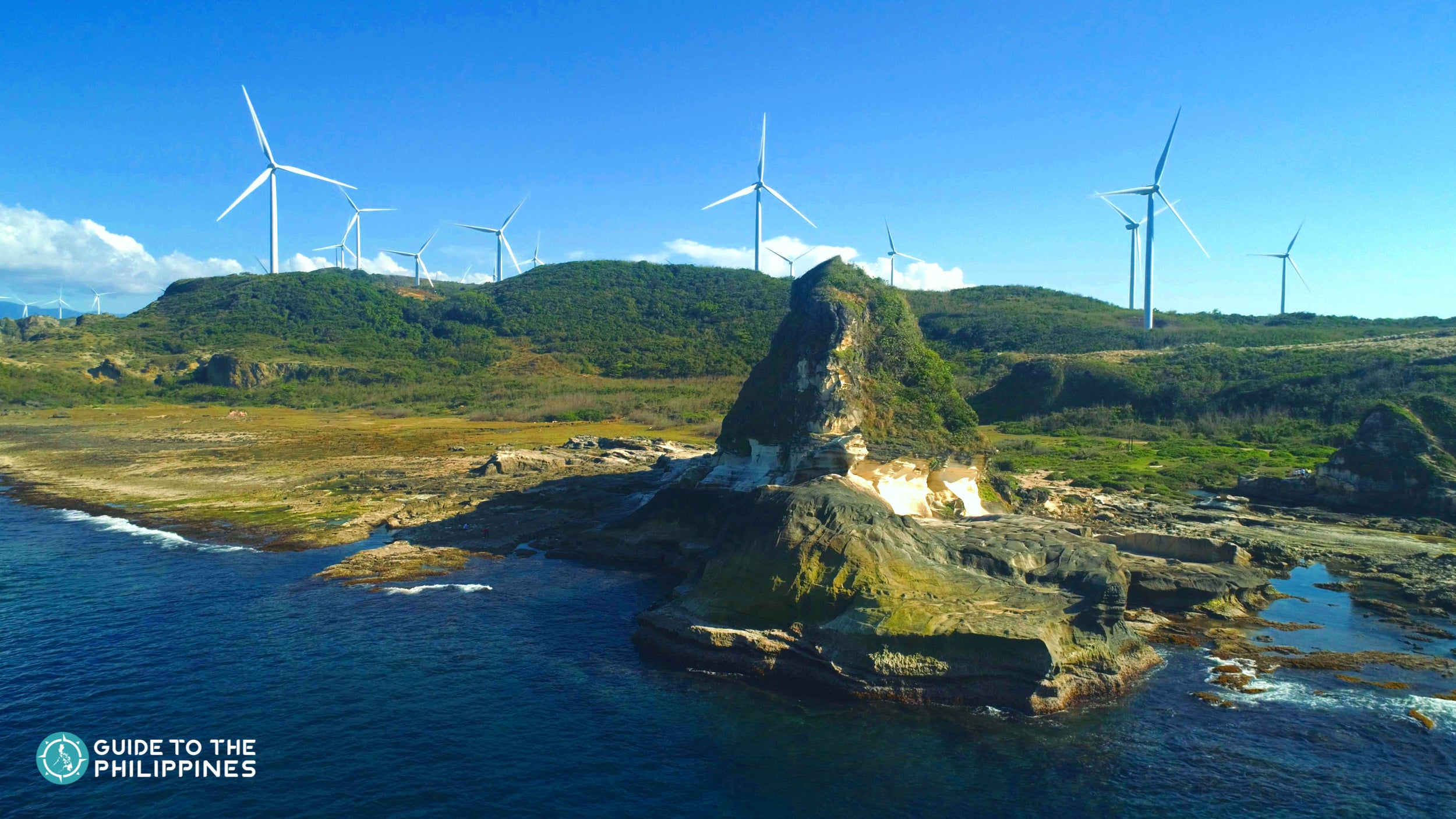
From centuries-old churches to wind-sculpted rock formations, Ilocos Sur and Ilocos Norte Provinces are filled with timeless stories that bring Philippine history and culture to life. As you stroll along the cobblestone streets of Vigan City or marvel at the massive buttresses of Paoay Church in Ilocos Norte, you'll feel like you’ve stepped into a different era.
Savor the local cuisine, bring home a piece of the north with handwoven crafts, or try your hand at pottery in a traditional workshop. Between cultural stops, cool off at Blue Lagoon Beach or Saud Beach in Pagudpud town, or get your adrenaline pumping on a 4x4 ride across the sand dunes.
For a stress-free and quick getaway with the perfect mix of history, nature, and adventure, book a tour package to Ilocos Norte Province, Vigan City, and La Union Town. If you want a longer vacation with everything arranged for you, choose a 5-day Ilocos Norte Package Tour with Airfare from Manila City and simply enjoy the journey. Whichever you choose, you’re in for an unforgettable escapade.
Frequently Asked Questions About Ilocos Region Tourist Spots
Ilocos Region is a captivating destination, offering a blend of rich history, cultural heritage, natural beauty, and thrilling adventures. To help you plan your visit, here’s a list of frequently asked questions that cover essential travel information about the region’s tourist spots and activities.
Where are Ilocos Sur and Ilocos Norte Provinces located?
The provinces of Ilocos Sur and Ilocos Norte are part of the Ilocos Region in the northern part of the Philippines. They are located approximately 400 km (249 miles) north of Manila City, the capital of the Philippines.
How long should I spend in Ilocos Region?
A minimum of 2 days is recommended to explore the Ilocos Region. However, 3 to 4 days would be ideal for a more leisurely pace, giving you time to relax and fully enjoy the region’s attractions.
How do I get to Ilocos Sur and Ilocos Norte Provinces?
You can reach the Ilocos Region by flying to Laoag City from Manila International Airport, or you can take a bus from Manila City. Buses to Ilocos Norte and Ilocos Sur depart from terminals such as the Partas Bus Terminal in Cubao District and Pasay City.
-
Flights to Laoag City from Manila City takes around 1 hour and 20 minutes.
-
By land, travel time varies: Manila City to Vigan City takes about 7 hours, while Manila City to Laoag City or Pagudpud town can take up to 12 hours.
Is it worth it to visit Ilocos Sur and Ilocos Norte Provinces?
Absolutely! Ilocos Region is rich in culture, history, natural beauty, and adventure. Whether you're exploring the Spanish colonial architecture of Vigan City, relaxing on the beaches of Pagudpud town, or enjoying thrilling activities like 4x4 rides on the sand dunes, Ilocos Region has something for every type of traveler.
What is the weather like in Ilocos Region?
The weather in the Ilocos Region is generally warm and dry, with a tropical climate. The best time to visit is during the dry season from December to May, when you can expect pleasant weather perfect for sightseeing.
What cultural and historical landmarks can I visit in Ilocos?
The provinces of Ilocos Sur and Ilocos Norte are rich in historical and cultural landmarks that showcase the region's heritage:
-
Vigan City – Famous for its well-preserved Spanish colonial architecture, especially along the photogenic cobblestone street of Calle Crisologo, lined with ancestral houses and charming shops.
-
Paoay Church – Dating back to 1710, Paoay Church is a UNESCO World Heritage Site known for its distinct blend of Baroque, Gothic, and Chinese architectural styles.
-
Vigan Cathedral – Located in the heart of Vigan City, this elegant church features a mix of Neo-Gothic and Baroque architectural styles.
-
Bantay Church Bell Tower – Dating back to 1591, Bantay Church features a historic watchtower once served as a lookout point during the Spanish colonial era and World War II.
What are the best beaches in Ilocos Region?
The top beaches in Ilocos Region are Saud Beach and Blue Lagoon, both located in the town of Pagudpud. These stunning white-sand beaches offer crystal-clear waters and great spots for swimming, sunbathing, and water activities.
What are some immersive cultural activities to do in Ilocos Sur or Ilocos Norte Province?
For a unique and immersive experience, try pottery-making at the Pagburnayan Jar Factory, where you can learn the ancient craft of creating traditional Ilocano pottery. You can also take a kalesa (horse-drawn carriage) ride along the cobblestone streets of Calle Crisologo in Vigan City
Are there any adventure activities in Ilocos Sur or Ilocos Norte Province?
Yes! One of the must-do adventure activities in Ilocos is a thrilling 4x4 ride across the Paoay Sand Dunes, where you can enjoy adrenaline-pumping action on the shifting sands. You can also try surfing in the beaches of Pagudpud town, where scenic waves and fewer crowds make it a great spot for both beginners and experienced surfers.
Is there a tour from Currimao Port for cruise passengers?
Yes, if you’re wondering what to see in Ilocos Region from your cruise ship, there are private shore excursions from Currimao Port tailored for cruise passengers. These tours include convenient port pickup and drop-off, letting you explore iconic sites in nearby Vigan City and Laoag City.
You’ll visit highlights such as Calle Crisologo, Bantay Church Bell Tower, and Paoay Church, ensuring a memorable and hassle-free day while docked at Ilocos Port.
What are other unique spots to check out in Ilocos Region?
Aside from the popular tourist spots, there are several unique attractions worth adding to your itinerary in Ilocos Region. These include:
-
Bangui Windmills: The first and largest windmill farm in Southeast Asia, Bangui Windmills offer a stunning view of the coast.
-
Kapurpurawan Rock Formation: A natural marvel, the Kapurpurawan Rock Formation features stunning white limestone formations sculpted by the wind, creating a breathtaking sight.
-
Patapat Viaduct: An impressive coastal road that stretches along the Ilocos mountainside, the Patapat Viaduct offers picturesque views of the ocean and surrounding mountains.
These spots offer a unique experience and provide excellent photo opportunities. Make sure to include them in your Ilocos Region adventure!
What are the must-try foods in Ilocos Region?
Don’t miss trying the iconic Ilocos empanada, a crispy, deep-fried pastry filled with local longganisa (Ilocano sausage), egg, and vegetables. Another must-try is Dinakdakan, a savory Ilocano dish made from grilled pork mixed with a flavorful dressing.
What transportation options are available in Ilocos Region?
Traveling around Ilocos Region is convenient with buses, vans, and tricycles. You can take a bus between Vigan City, Laoag City, and Pagudpud town. To visit more remote spots, you can hire a tricycle in Pagudpud town or Laoag City.
Pro-tip: For a more seamless experience, consider booking a guided tour that includes transportation, making your travels hassle-free.
What’s the best way to explore Ilocos Region?
You can go around and explore Ilocos Sur and Ilocos Norte provinces using public transportation, such as buses or vans, to travel between cities and towns like Vigan, Laoag, and Pagudpud.
However, for a more convenient and hassle-free experience, it's highly recommended to book tours with transportation included or opt for a private transfer between Laoag City and Vigan City. This way, you won’t have to worry about planning routes or switching between multiple rides—just relax and enjoy the journey.
What is the best time to visit the Ilocos Region?
The ideal time to visit Ilocos Region is during the dry season, from December to May, when the weather is pleasant and perfect for sightseeing.
Are there ATMs in Ilocos Region?
Yes, ATMs are available in most major towns and cities in the Ilocos Region, including Vigan City and Laoag City. However, it’s still best to bring enough cash and loose change, especially if you plan to take public transportation or visit tourist spots in smaller towns where ATM access may be limited.
Are Ilocos Sur and Ilocos Norte tourist spots child-friendly?
Yes, many tourist spots in Ilocos Sur and Ilocos Norte are family-friendly, including scenic beaches and historical landmarks.
However, some adventure activities, such as the 4x4 ride at Paoay Sand Dunes, may not be suitable for younger children and may require parental supervision. It's important to consider the child's age and comfort level with the ride, as it can be somewhat bumpy and exciting. Younger children (under 3-4 years old) may find the ride too intense, so it's recommended to have them seated securely or in front of a parent or guardian.
Are Ilocos Sur and Ilocos Norte tourist spots accessible for senior travelers?
Yes, Ilocos Region has many accessible attractions for senior travelers, including scenic spots, historical landmarks, and cultural experiences. Many places, such as Vigan’s Calle Crisologo, Paoay Church, and the Bangui Windmills, are easily accessible and suitable for seniors. However, some areas with rugged terrain or activities may require extra physical effort.
For example, the 4x4 ride at Paoay Sand Dunes or the climb to the top of the Bantay Church Bell Tower may be more challenging for those with mobility concerns. Additionally, exploring the Kapurpurawan Rock Formation involves walking on uneven surfaces, which can be physically demanding.
It’s important to plan ahead and consider the level of activity to ensure a comfortable experience. It's always a good idea to check if a location offers any accessibility features, such as ramps or benches, to make the visit easier.
Are there entrance fees to tourist spots in Ilocos Norte and Ilocos Sur?
Yes, here’s a breakdown of entrance fees to popular spots:
-
Kapurpurawan Rock Formation – Php 30 per person
-
Paoay Sand Dunes – Free entry, but a 4x4 ride with sandboarding costs Php 2,500 per jeep (good for 3–4 people)
-
Bangui Windmills – Free
-
Calle Crisologo – Free
-
Patapat Viaduct – Free
-
Paoay Church – Free
-
Vigan Cathedral – Free
What should I pack for my trip to Ilocos Region?
Pack light clothing for the warm weather, comfortable walking shoes for exploring historical sites, and an umbrella or sunblock for protection from the sun. You may also want to bring a jacket for cooler evenings or air-conditioned transport.


